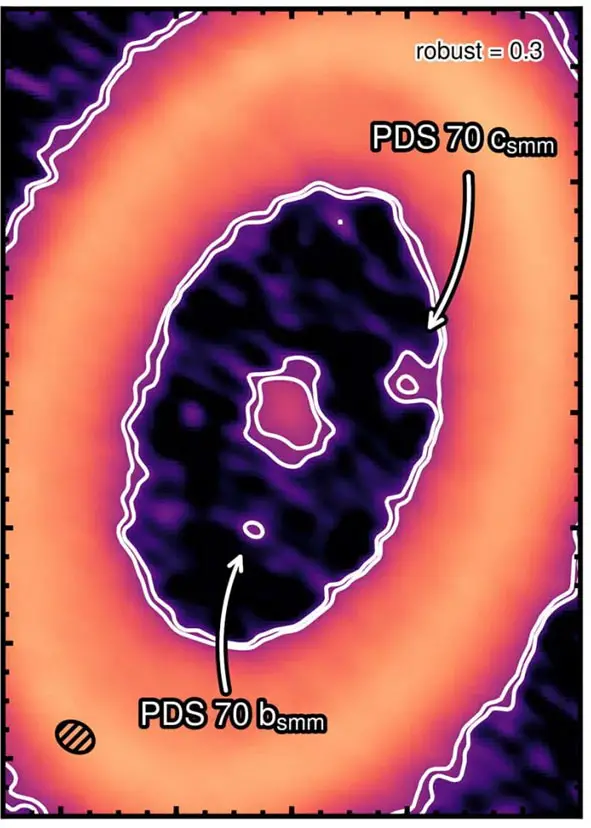
20th July 2019 Moon-forming disk discovered around exoplanet Astronomers report, for the first time, detection of a moon-forming circumplanetary disk around a distant planet.
Using Earth's most powerful array of radio telescopes, astronomers have made the first observations of a circumplanetary disk of gas and dust – like the one that is believed to have birthed the moons of Jupiter and other gas giants. This never-before-seen feature was revealed by the massive, 66-antenna Atacama Large Millimeter/submillimeter Array (ALMA) in Chile. It detected the disk in a system called PDS 70, around 370 light years from Earth. This contains a T Tauri, a type of young star (in this case, only five million years old), that is still undergoing gravitational contraction. T Tauris represent an intermediate stage between a protostar and a main sequence star like our Sun. Also present are two nascent exoplanets, named PDS 70b and PDS 70c, which, like their T Tauri parent, are in the process of forming. PDS 70b is a large and hot gas giant, a few times greater than Jupiter in mass, with a temperature estimated at 1000 °C (1832 °F) and an atmosphere with clouds. Its orbit has a radius of 3.2 billion km (21.5 au), which is similar to Uranus. The second planet, PDS 70c, is less massive and orbits further out, at 5.31 billion km (35.5 au), which is similar to Neptune. Computer models had earlier predicted a disk around PDS 70c, which is now observationally confirmed. A disk may also potentially exist around PDS 70b, but is yet to be confirmed.
A circumplanetary disk is a torus, pancake or ring-shaped accumulation of gas, dust, rocks and collision fragments in orbit around a planet. ALMA was able to image the faint radio waves given off by tiny (about one tenth of a millimetre across) particles of dust around the star. This new data – combined with earlier optical and infrared observations by the Very Large Telescope (also in Chile) – provides compelling evidence that a disk capable of forming multiple moons surrounds the outermost known planet in the system. Most models of planet formation show that circumplanetary disks vanish within about 10 million years, which means none have existed in our Solar System for more than four billion years. To find them elsewhere and gather observational evidence, astronomers are searching for very young star systems where they can directly observe disks and the planets still forming inside them. "For the first time, we conclusively see the tell-tale signs of a circumplanetary disk, which helps to support many of the current theories of planet formation," said Andrea Isella, an astronomer at Rice University in Houston, Texas, and lead author on a paper published in the Astrophysical Journal Letters. "By comparing our observations to the high-resolution infrared and optical images, we can clearly see that an otherwise enigmatic concentration of tiny dust particles is actually a planet-girding disk of dust; the first such feature ever conclusively observed," he said. According to his team, this also is the first time that an exoplanet has been clearly seen in these three distinct bands of light. "There's much that we don't understand about how planets form – and we now finally have the instruments to make direct observations and begin answering questions about how our Solar System formed, and how other planets might form." Optical studies of planetary systems are notoriously challenging. Because the star is so much brighter than the planets, it is difficult to filter out the glare – somewhat like trying to spot a firefly next to a search light. ALMA observations, however, overcome this problem, since stars emit comparatively little light at millimetre and submillimetre wavelengths. "This means we'll be able to come back to this system at different time periods and more easily map the orbit of the planets and the concentration of dust in the system," concludes Isella. "This will give us unique insights into the orbital properties of solar systems in their very earliest stages of development." In the future, next-generation observatories such as the James Webb Space Telescope and WFIRST could also study this system, using higher resolutions and newly-developed spectral techniques to measure the temperature, density and other characteristics of the disk.
Comments »
If you enjoyed this article, please consider sharing it:
|









